#rorcrfr – Not only did the Rolex Fastnet Race 2015 provide two completely different sailing experiences all in the one event package, but this 90th Anniversary of the Grand National of Offshore Racing was so suffused with historical references and resonances that the fleet of 370 boats sailed in company with ghosts. Friendly ghosts maybe, but ghosts nevertheless. For this was more, much more, than just a big and demanding race with everything done and dusted once the results were finalised.
An event which operates at so many different levels obviously offers opportunities for added value as the weeks pass, but even at this stage sponsors Rolex must be well pleased with the positive exposure they've received. However, W M Nixon has a further idea which might just have legs or even wings, and he launches straight into it before rounding out our coverage of this megafest of sailing.
If they wanted to make the up-coming Southampton Boat Show really interesting, then they should try to have as many of the Rolex Fastnet Race class winners as possible on display there. Not showroom-ready sister-ships where the winners were tuned-up production boats. No, to bring the show really alive, what we need is the actual boats themselves, just as they are this morning after the post-race tidy-up in Plymouth.
The sheer variety of boats which have done well has resulted in 2015's race being one enormous, carefully observed and closely- monitored tank test. We now have almost more data than can be fully assessed to help in guiding people towards making boat purchase choices, or in modifying existing boats.
But while theory and results from data is all very well, there's nothing like seeing it for yourself. Not some sister-ship. Not some replication. But the actual real living breathing boats which went out and did the business. That would provide a real boat show, as opposed to a formulaic display.
The idea might be a runner for the smaller boats, but as we go up the size scale, we're into different territory. For the huge attention which the Rolx Fastnet Race receives for its ten days in the limelight is a reminder that for most of the time, Corinthian offshore racing is a very private affair, and that's the way the participants like it.
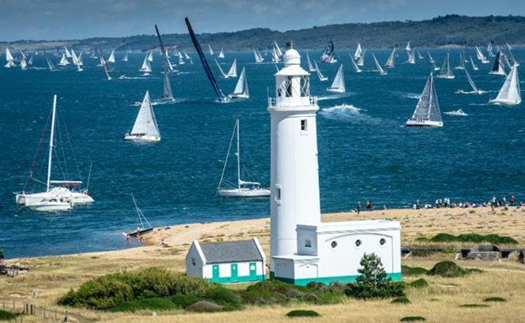
It's the greatest boat show of them all....a section of the Fastnet fleet on Sunday afternoon, enjoying the sea breeze while the ebb tide sweeps them past Hurst Point lighthouse.
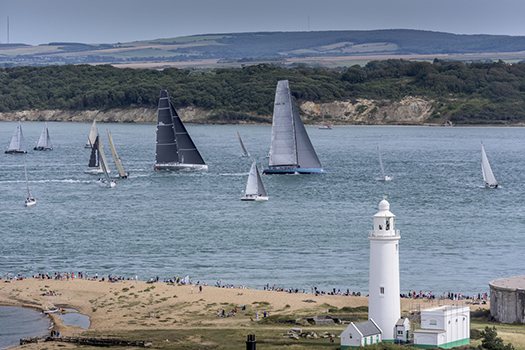
Garden sailing....the scene as Leopard leads Rambler 88 out of the Solent on Sunday is in marked contrast to the rugged mood which prevails at the Fastnet Rock even in calm.
For instance, two of the boats which figured well were Dieter Schoen's Maxi 72 Moma, and Michael Bartholomew's GP 72 Tokoloshe II. In both cases, the boats are in tightly organised very professionally administered class structures which provide guaranteed sport and level racing at regattas which are, well.....rather exclusive affairs. And they're inevitably at high end venues too.
That Momo and Tokoloshe II did well in an open event like the Fastnet will be very satisfying to their fellow owners in their respective classes. But those other owners meantime prefer to do their sailing in their own tight-knit group where - if have to ask how you go about joining, chances are you've already excluded yourself.
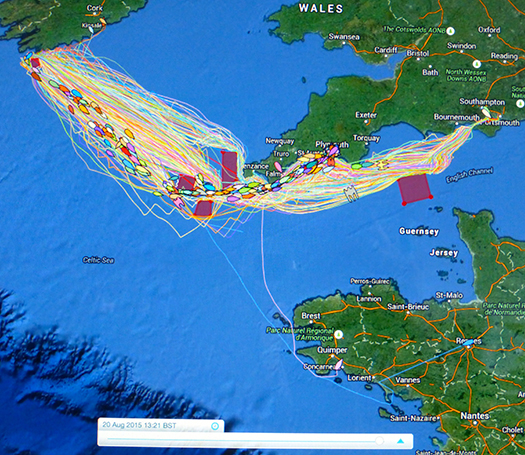 What a tangled web we weave.....the Rolex Fastnet Race 2015 Race Tracker at 13.21 on Thursday, when last boat Floating Point rounded the Fastnet Rock
What a tangled web we weave.....the Rolex Fastnet Race 2015 Race Tracker at 13.21 on Thursday, when last boat Floating Point rounded the Fastnet Rock
Excessively private, perhaps, but it does produce some interesting boats. The Maxi 72s are the better known, and Momo is the latest Judel Vrolik take on the type with an eye on the IRC. But the GP 42s, which have been on the go as a development class since 2006, are much the more numerous. To be found throughout Europe but with a definite Mediterranean emphasis, they're under the overall control of the Offshore Racing Congress, so in the case of Tokoloshe II it was an interesting challenge for designer Sean Carkeek of South Africa to produce the new boat in 2014 to comply with the ORC Rule while being optimized for the IRC.
We particularly noticed Tokoloshe II in the Fastnet, for no matter how hard the O'Learys on Antix were working to make good the damage done by being becalmed at the Isles of Scilly while outward bound for the rock, Tokoloshe II – only slightly bigger – always seemed to be going that bit faster, and at the finish even though smaller boats came from astern, Tokoloshe was able to hang onto second in Class 1, but Antix slipped to 14th.
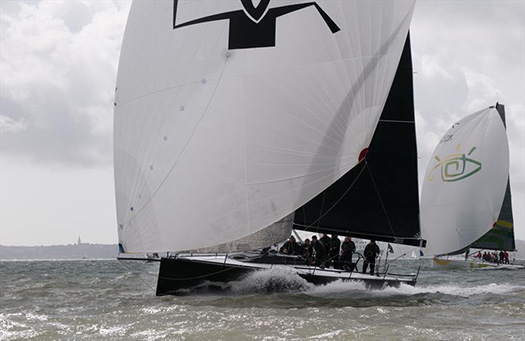
She's fast. The GP42 Tokoloshe II was just that bit quicker than Antix

Even the slightest of zephyrs can get the 100ft Comanche going, as seen here with the Fastnet beyond. So it was truly and utterly windless when she was stopped at the Fasthet for exactly four hours – precisely on skipper Kenny Read's watch that night. Photo: Rolex/Kurt Arigo
Another set of Fastnet racing boats which would greatly enhance any public Boat Show, but are unlikely to be at Southampton, is the remarkable array of classic Sparkman & Stephens yawls – Dorade (52ft) which won the Fastnet in 1931 and again in 1933, Stormy Weather (53ft) which won in 1935, and Argyll (57ft) which won the Bermuda Race in 1950.
Dorade and Stormy have exactly the same IRC rating, and they came round the rock with Stormy just in the lead. But the older Dorade with her hugely experienced crew gradually worked through to the front and did so well she was second overall in Class 4, while Stormy Weather was fourth.
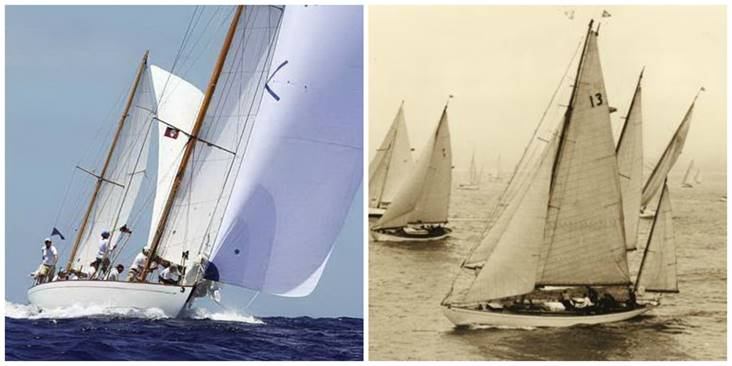
Two ages of Dorade - as she is today (left), and as she was at the start of the 1931 Fastnet Race, which she won
With so much history right there in the mix with the very latest boats, the sense of Irish involvement in times past was as much present as the following of Irish boats this time round. In fact, it has only been a so-so race for the Irish, thus we'll allow ourselves a little wallow in the good old days. Last week in previewing the race we highlighted Ger O'Rourke's great overall win in 2007 with Chieftain, and we also mentioned Mick Cotter's fine fifth overall in 2009. Other successes which spring to mind are the victory in the very competitive Class I in the 1981 race by Ken Rohan's Holland 40 Regardless, a boat so special she is now reserved in a classic racers maritime museum in Florida.
And then there's the overall win in the Fastnet Race of 1987 by the Dubois 40 which had her usual name of Full Pelt clearly across the transom, but on the side it said Irish Independent. For of course Full Pelt Indo was the top member of the 1987 Irish Admiral's Cup Team, and her overall victory in the 1987 Fastnet contributed mightily to the points total of our Admiral's Cup team – managed with boundless energy by Sean Flood – which got our best result in the AC, fourth out of thirteen very hot teams.
Nevertheless it was something of a grey area at the time, as the boat was known by the two different names, and while some key personnel on board were Irish, the core of her Solent-based crew was retained. On top of that, sponsorship was still a very contentious issue, so although Irish Independent was overall winner of the 1987 Fastnet Race, the Fastnet Trophy went to the leading un-sponsored boat, while all that the Full Pelt Indo crew got for their trouble was a little silver salver which team captain Tom Power rightly described as "a leprechaun's hub-cap".
But after all these years, we now see it for the famous victory it really was. Owned by Stephen Fein, Full Pelt was optimized – as were all the Fein boats – by the great Jo Richards, a genius in rating tweaking, and an extremely good sailor with it. Thus when the series started, Jo had the boat sitting on a rating which was just a very tiny fraction less than her immediate rivals. He loved boat-for-boat racing, so when the forty footers came roaring into the Fastnet's running finish at Plymouth in line abreast, Jo and his crew knew they had to be only half-a-boatlength ahead to win, and he did it to perfection.
But as well, the Irish input had brought the extraordinary talent of Tim Goodbody on the helm, as well as Tom Roche, Tom Power and Billy Pope in the crew. Tim had already shown his mettle by out-sailing Lawrie Smith in the sister-ship Jamarella in a grinding tacking duel in one of the Admiral's Cup inshore races in the Solent, but his Dublin Bay talent proved equally adept offshore, and Full Pelt Indo was sailed with that special confidence which ensured her ultimate victory, even though it seemed a close run thing at times.
But that was then, this is now, and in August 2015 we're looking at a Fastnet Race in which the Gull Salver for the best-placed Irish boat is set to go to Michael Boyd's Grand Soleil 43 Quokka. While he is very much Commodore of the RORC, his crew included such fellow Royal Irish YC alumni as tactician-helmsman Barry Hurley and navigator Stephen Lee.

Quokka (Michael Boyd) is best of the Irish in the Rolex Fastnet Race 2015. Photo: Rick Tomlinson

Michael Boyd's Quokka, sailed by Barry Hurley and navigated by Stephen Lee
On Thursday night we were recording Quokka as being 44th overall, but the final tally after the rush of smaller boats through Thursday night and Friday morning has her at 58th. If that seems a modest enough placing for Ireland's top boat, we've a link at the end of this blog to the complete results, so if it rains tomorrow as expected, you can be snugly indoors noting just how many superstar boats are behind Quokka in that final ranking.
But of all the huge fleet in this race of two races – the first one from Cowes in zephyrs to the Isles of Scilly, the other in a grand Atlantic breeze from Scilly out round the rock and back again to Plymouth - it is the boats created by Jean Pierre Kelbert in his yard near the entrance to the Morbihan at the south end of Brittany which have most positively made their mark.
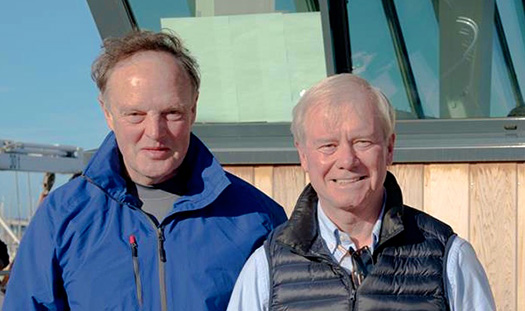
Michael Boyd, Commodore RORC (left) with Gery Trentesaux, overall winner of the Rolex Fastnet Race 2015
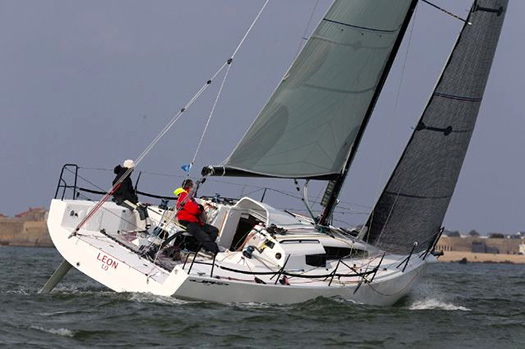
A very interesting and thoroughly worthwhile boat – the JOK 10.8 Courier Du Leon, overall Fastnet winner
It's the second Fastnet Race in a row with a JPK winner, but ace skipper Gery Trentesaux's win this time round with Courier du Leon is in a league of its own, nearly two and a half hours clear ahead at the finish, and already in the lead when rounding the Fastnet Rock.
JPK have been building boats since 2002, and their designer Jacques Valer prefers the twin rudder configuration which gives that extra vital control for a wedge-shaped hull. The setup has many other advantages, as the rudders can be smaller, and should one fail, you've always got the other. In fact, perhaps the only drawback is that neither rudder is immediately aft of the propeller. Thus when manoeuvring under power in a tight spot, you don't have recourse to prop-thrust to spin the boat. But that is likely to be far from your mind in barreling along under full control on a tight spinnaker reach, while single-rudder boats are broaching all around you and – increasingly – well astern.
We've a link to a vid below which has Jean Pierre – he's a former professional wind-surfer – enthusing about the first JPK 10.80 launching in February 2014. Even if you can't keep up with his French, it gives a good overview of an extremely interesting boat which has lots of novel and worthwhile ideas. That big forward-facing window is a super notion, for instance, not least for safety in keeping an easy lookout from below. But in general she's an unextreme boat – no excessive bulb on the keel, for instance – and in all, the fact that she has been such a success reflects great credit on the designer and builder, but also provides real kudos for the IRC Rule – encouraging boats like the JPK 10.80 is good news for serious sailors.
As for the thousands of non-JPK sailors who emerged with less success from the Fastnet, that's the way it is with boat racing. With a fleet of this unprecedented size, the vast majority are going to sail home with no silverware to show for it. Yet it won't have been a meaningless. Even doing the Fastnet Race only once leaves you with an experience which will be with you for ever. And fundamental to all this is the very special turning point itself. Without the lighthouse, the Fastnet would be just another rock. But the lighthouse is what gives it that vital human dimension. It is as nearly perfect a lighthouse as possible.
So next time you round it, reflect for a moment that James Kavanagh, the master stonemason from Wicklow who built the Fastnet lighthouse from start to finish, was so determined to get it as good as possible that he continued working through his final illness, and had a terminal stroke as he personally supervised the final stone going into place in 1904.
Now here are the Rolex Fastnet Race 2015 results
































































